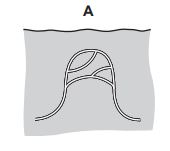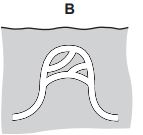
Homeostasis II
Quiz
•
Biology
•
10th - 11th Grade
•
Hard
Standards-aligned

Charles Martinez
FREE Resource
5 questions
Show all answers
1.
MULTIPLE CHOICE QUESTION
30 sec • 1 pt

The diagram shows a capillary loop in the skin of a mammal.
What will the capillary loop look like if the mammal becomes cold?




Tags
NGSS.HS-LS1-3
2.
MULTIPLE CHOICE QUESTION
30 sec • 1 pt

What would be the effects of vasodilation and sweating on the body temperature and on the amount of moisture on the surface of the skin?
A
B
C
D
Tags
NGSS.HS-LS1-3
3.
MULTIPLE CHOICE QUESTION
30 sec • 1 pt
During a long race, an athlete’s skin temperature rises. What causes this?
A increased sweating
B opening of the pores in the skin
C vasoconstriction of the blood vessels in the skin
D vasodilation of the blood vessels in the skin
Tags
NGSS.HS-LS1-3
4.
MULTIPLE CHOICE QUESTION
30 sec • 1 pt
Read the following sentence. In order to prevent the human body from losing heat, the arterioles supplying the skin become narrow.
Which process does this sentence describe?
A constriction
B shivering
C sweating
D vasodilation
Tags
NGSS.HS-LS1-3
5.
MULTIPLE CHOICE QUESTION
30 sec • 1 pt

When the body temperature rises above 37 °C, which changes help to return the temperature to normal?
A
B
C
D
Tags
NGSS.HS-LS1-3
Similar Resources on Wayground

10 questions
Understanding Homeostasis
Quiz
•
10th Grade

10 questions
Integumentary System Anatomy
Quiz
•
11th - 12th Grade

10 questions
1 Stem Cells - Higher Human Biology
Quiz
•
10th - 12th Grade

10 questions
Amoeba Sisters: Mitosis vs. Meiosis Challenge!
Quiz
•
6th Grade - University

10 questions
AMSTI: African Dwarf Frogs
Quiz
•
KG - University

10 questions
AP Bio Insta-Review Topic 2.1
Quiz
•
9th - 12th Grade

10 questions
AP Bio Insta-Review Topic 1.4
Quiz
•
9th - 12th Grade

9 questions
Thermoregulation and Metabolism
Quiz
•
9th - 12th Grade
Popular Resources on Wayground

10 questions
Video Games
Quiz
•
6th - 12th Grade

10 questions
Lab Safety Procedures and Guidelines
Interactive video
•
6th - 10th Grade

25 questions
Multiplication Facts
Quiz
•
5th Grade

10 questions
UPDATED FOREST Kindness 9-22
Lesson
•
9th - 12th Grade

22 questions
Adding Integers
Quiz
•
6th Grade

15 questions
Subtracting Integers
Quiz
•
7th Grade

20 questions
US Constitution Quiz
Quiz
•
11th Grade

10 questions
Exploring Digital Citizenship Essentials
Interactive video
•
6th - 10th Grade
Discover more resources for Biology

20 questions
Cell organelles and functions
Quiz
•
10th Grade

20 questions
Cell Membrane and Transport
Quiz
•
10th Grade

20 questions
Section 3 - Macromolecules and Enzymes
Quiz
•
10th Grade

20 questions
Macromolecules
Quiz
•
10th Grade

12 questions
Macromolecules
Lesson
•
9th - 12th Grade

20 questions
Cell Transport
Quiz
•
9th - 12th Grade

16 questions
Population Ecology
Quiz
•
9th - 12th Grade

51 questions
2025 Biology TEST 1 Review
Quiz
•
9th - 12th Grade
